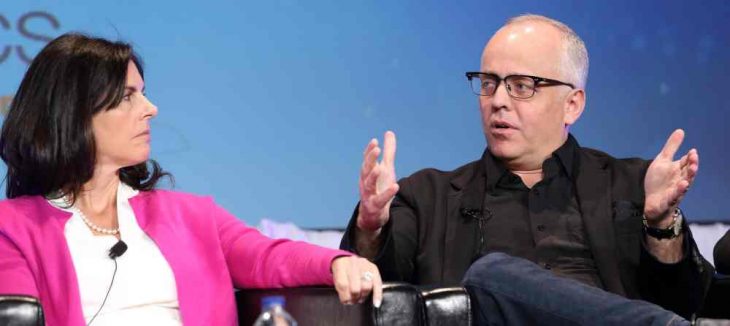
TORONTO – Carriers, broadcasters, content providers and media companies wonder about what viewers want to consume these days as the digital world expands. So it was appropriate that a Canadian executive of one used food to talk about the future of traditional TV and new media.
“I think there's a lot of 'empty calories' in the televison space right now (with content) that people aren’t passionate about,” David Purdy, chief international growth officer at Vice Media, told the Canadian Telecom Summit on Wednesday (pictured with Corus Entertainment's Maria Hale).
“Ad dollars are going to shift to where people are passionate about content.”
The U.S. -based AMC cable network “proved you don't need a ton content, you just need five or six shows people are really passionate about,” he argued as an example. Now it has leverage over cable channels and can “jack up rates and create massive shareholder value.” AMC is perhaps best known for The Walking Dead, Breaking Bad and before that, Mad Men, which has anchored a schedule otherwise filled with old movies – and Purdy, in his former role at Rogers Cable, was once forced to pay those jacked up rates.
Purdy was one of several on a panel discussing the future of linear TV, cable broadband providers and mobility.
While younger people are signing up for over the top (OTT) services, sometimes cutting cable and doing other things with their TVs like playing games, and Netflix has become a big content provider, panellists agreed traditional television isn't going away soon. In fact, some pointed out digital content providers (like Vice) are increasingly expanding to traditional television.
While the CRTC reports that last year 100,000 Canadians dropped their cable or satellite subscriptions, many were merely unhappy with the bundled services they had to buy, argued Maria Hale, senior vice president of global entertainment at Corus Entertainment. Some are going to new platforms but “as far as linear TV goes in the traditional space think it will stabilize.”
“As for digital players, they always want to migrate into the traditional space,” she said, noting OTT players like Amazon are adding streaming channels. And while Netflix has recently been active in picking up first run rights for shows, increasingly production studios are shying from getting too close to it as they work out their business models to make sure they're growing their business overall.
The future “will see blending of products that customers can chose from,” she said.
Purdy predicts over the next 24 months OTT providers will come out with subscription television channels, making them look like cable. That could give a lift to content providers, he said. He also noted that his company, Vice Media, launched a linear channel in order to get advertisers it couldn't reach online as well as content providers who didn't want to produce only for the digital market.
Vice's move says a lot about linear TV, argued David Asch, senior vice-president of Shomi, a streaming service co-owned by Rogers and Shaw Communications. Traditional TV offers “great audience, advertisers, and content creators want to play there,” he said, predicting “a good future and healthy future for linear TV.”
On the other hand, Vikas Gupta, CEO of Big Blue Bubble, a London, Ont.-based developer of mobile games, said the definition of media is changing. “We see consumers wanting much more bite-size content,” like 11-minute dramas on online platforms like Hulu and YouTube.
“If you're a standalone regional player you have to either have an international buying alliance or equity partners who are going to help you out.” – David Purdy, Vice Media
“I don’t see traditional TV disappearing away any time soon, but through over the top and all the IP connected devices out there, traditional formatting will start to change… and there will be a blending between what's interactive and what's purely linear.” As that happens, he also warned there will be “a lot of breakage in business models.”
He also noted that his firm makes lot of money from people willing to donate money for the free games it offers. It's a lesson for traditional TV, he said.
There are those who argue that all the content that is being delivered through various platforms offers viewers the ability to personalize their content, grabbing traditional TV shows, streaming, and mobile video onto one screen. One problem, Hale pointed out, is finding all the stuff.
The traditional set-top box is a big limitation, she argued, leaving subscribers to complain there’s nothing on because they can't find content easily. This “discoverability” problem has to be solved for personalization to be realized.
With 200 streaming channels available, Purdy said, a provider who can weave them into an offering is a big opportunity. He pointed to U.S. cableco Comcast and its Xfinity service, which can search across live TV, On Demand, and the subscriber's DVR library for content, as the way of the future.
Purdy also pointed out how the enviroment has changed for providers when Netflix recently announced it had bought the rights to a series based on the Marvel comic Defenders series – without competitive bidding. “No doubt that if you're a standalone regional player you have to either have an international buying alliance or equity partners who are going to help you out” buying international content. So, for example, he suggested Shomi partner with online provider Hulu (a joint venture between Disney and the U.S. ABC TV network).
Few would disagree with Purdy's comment that overall “there's a lot of exciting things to come.”
Photo by Howard Solomon.



